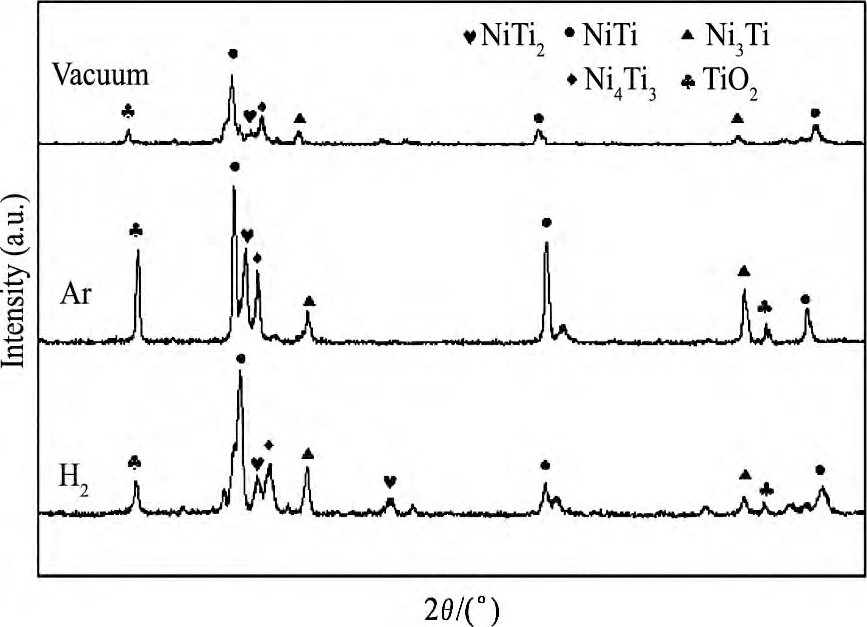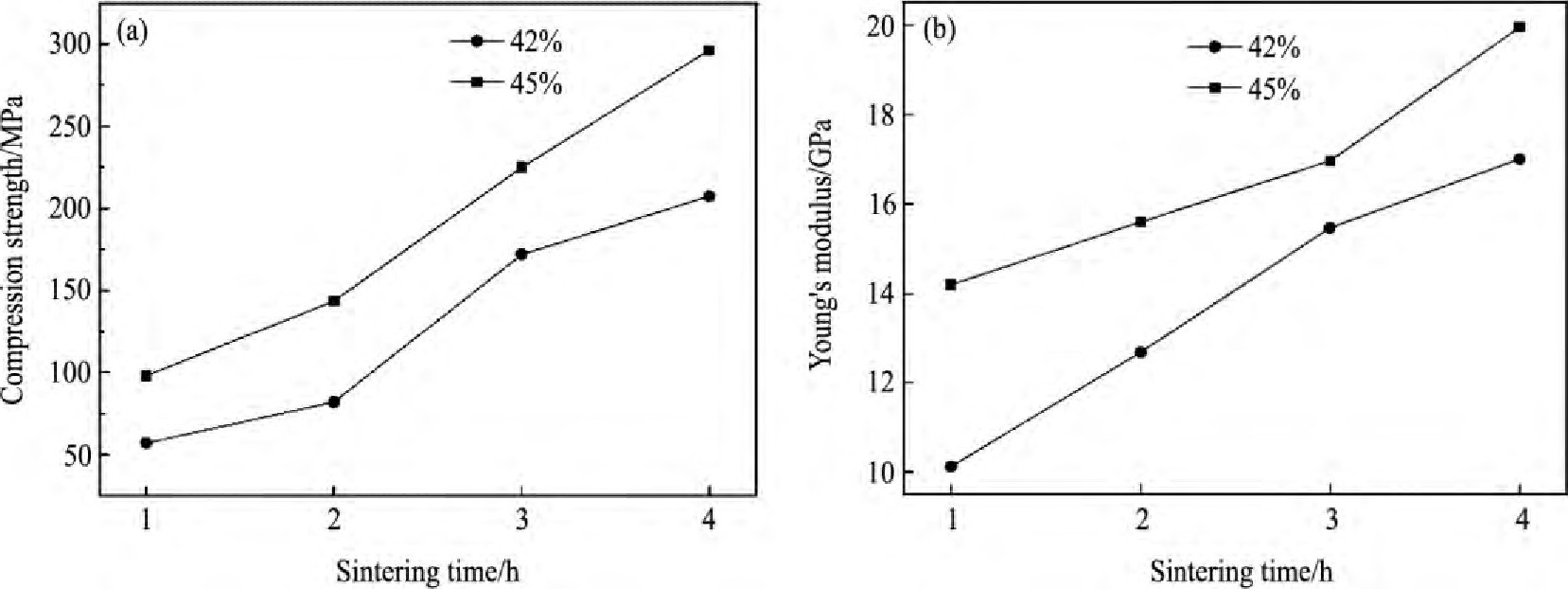网络首发时间: 2017-05-04 10:46
烧结气氛及时间对凝胶注模成形多孔NiTi合金性能的影响
中南大学材料科学与工程学院
摘 要:
多孔NiTi合金由于其优异的形状记忆性能和生物相容性而广泛应用于医用植入材料领域。以雾化Ni粉和机械破碎法制备的TiH2粉末作为原料, 以甲基丙烯酰胺作为单体, 通过凝胶注模工艺制备出了性能良好的多孔NiTi合金, 研究了不同烧结气氛和保温时间对多孔NiTi合金孔隙率、微观组织及力学性能的影响。结果表明:烧结气氛对烧结体的各项性能均具有较大的影响, 同氩气及氢气气氛下烧结相比, 真空烧结得到的合金孔隙分布均匀, 相组成均一, 孔隙率及机械性能较好, 是理想的烧结气氛;随着烧结时间的增加, 合金孔隙率降低, 孔径分布更加均匀, 抗压强度和杨氏模量增加, 同时物相组成并未出现太大变化, 单一的NiTi相很难通过延长保温时间来获得。对于固相体积分数分别为42%和45%的坯体, 在真空环境下, 烧结时间由1 h增加到4 h, 其孔隙率分别由49.58%和48.52%降低到35.01%和33.49%, 抗压强度由57.13和98.04 MPa增加到207.34和296.14 MPa, 弹性模量由10.12和14.2 GPa增加到17.01和19.96 GPa。
关键词:
中图分类号: TG146.23
作者简介:段柏华 (1972-) , 男, 湖南安仁人, 博士, 副教授, 研究方向:粉末冶金、难熔金属和多孔材料;电话:0731-88877221;E-mail:duan-bh@csu.edu.cn;
收稿日期:2017-03-03
基金:湖南省自然科学基金项目 (2015JJ2170);国家自然科学基金项目 (51274246) 资助;
Properties of Porous NiTi Alloy by Gel-Casting with Different Sintering Atmosphere and Sintering Time
Duan Bohua Zhang Yasong Wang Dezhi Xie Chunge
School of Materials Science and Engineering, Central South University
Abstract:
Porous NiTi alloy was widely used as medical implant materials because of its excellent shape memory performance and biocompatibility. Porous NiTi alloy was fabricated by gelcasting with MAM as monomer, using atomized nickel powder and titanium hydride powder by mechanical crushing as raw material. The effects of sintering time and sintering atmosphere on the mechanical property, microstructure and phase composition of porous NiTi alloy were studied. The results showed that the sintering atmosphere had an important influence on the various performance of the alloy. Compared with argon and hydrogen atmosphere, porous NiTi alloy sintered in high vacuum had equable pore distribution, homogeneous phase, better porosity and mechanical property, which was ideal sintering atmosphere. The extent of sintering time, the porosity of sintered alloy decreased and the compression strength and Young' s modulus increased, with more equable pore distribution. However, there was no obvious change in the phase composition. It was hard to get single NiTi phase by increasing sintering time. For the solid loading of 42% and 45%, at vacuum atmosphere, with the sintering time increasing from 1 to 4 h, the porosity of sintered NiTi alloy decreased from 49. 58% and 48. 52% to 35. 01% and 33. 49%, while the compressive strength increased from 57. 13 and 98. 04 MPa to 207. 34 and 296. 14 MPa, and the elastic modulus increased by 10. 12 and 14. 2 GPa to 17. 01 and 19. 96 GPa, respectively.
Keyword:
gel-casting; porous NiTi alloy; sintering atmosphere; sintering time;
Received: 2017-03-03
Ni Ti合金由于其独特的形状记忆效应和超弹性, 良好的生物相容性等特点, 在生物医用材料应用领域得到广泛应用[1]。多孔Ni Ti合金不但保持了以上的优点, 其孔隙结构能够有效降低材料的弹性模量, 使其弹性模量与骨骼达到最佳匹配, 避免“应力屏蔽”现象的发生[2];同时孔隙结构的存在也有助于骨组织的长入和营养成分的运输, 使植入体的各项性能都与人体组织更加匹配[3]。正是由于多孔Ni Ti合金在生物医用材料方面展现出的巨大潜力, 近年来, 国内外学者们对多孔Ni Ti合金的制备进行了不同方式的探索, 如常规粉末冶金法 (CS) [4], 自蔓延高温合成法 (SHS) [5], 热等静压烧结法[6], 微波烧结法[7]等。但这些方法均难以直接制造复杂形状的零件及移植体, 若通过后继加工来制备复杂移植体, 由于多孔材料呈本征脆性, 不仅其加工困难、加工成本高、材料浪费大, 而且会损坏其多孔结构并影响最终使用性能。粉末注射成形技术虽然能够制备复杂形状的零件, 但不适用于尺寸较大的零件或移植体的制造[8,9,10]。因此, 寻求一种制备综合性能良好的多孔Ni Ti合金及复杂形状部件的近净成形技术就显得非常重要[11]。
凝胶注模成形技术作为一种新型粉末近净成形技术, 其主要原理是基于有机单体原位固化反应并固定均匀悬浮的粉末进行成型[12,13], 对于大尺寸, 形状复杂零件的制备具有很大优势, 且模具成本低廉, 不需要专门的成型设备[14], 通过改变固相体积分数可以得到不同孔隙和机械性能, 是一种很好的多孔材料制备方法, 在复杂形状陶瓷的成型方面得到了广泛应用[15,16]。近年来, 该技术开始应用于金属粉末成型方面, 目前已经成功制备出了H13工具钢[17]、Ni合金[18]、钛合金[19]、多孔铝[20]、Ti Al合金[21]等材料。以还原Ti粉和Ni粉作为原料, 以丙烯酰胺作为单体, 探索了凝胶注模工艺制备多孔Ni Ti合金[22], 但钛粉易于氧化且成本贵, 而且丙烯胺对人体神经有较大的毒害作用, 这些均限制了此项技术的应用。本文则以Ti H2粉代替Ti粉作为原料, 并采用低毒性甲基丙烯酰胺作为单体, 制备出性能良好的多孔Ni Ti合金, 并重点研究烧结气氛、烧结时间对多孔Ni Ti合金孔隙率、微观形貌、物相组成及力学性能的影响。
1 实验
1.1 原料
使用雾化Ni粉 (纯度99.5%以上, 平均粒径28.41μm) , 机械破碎法制备的Ti H2粉 (纯度99.5%以上, 平均粒径9.59μm) 作为粉末原料。凝胶注模过程用到的化学试剂有:单体甲基丙烯酰胺 (MAM, 天津化学试剂研究所) , 交联剂N, N'-亚甲基丙烯酰胺 (MBAM, 天津科密欧化学试剂有限公司) , 分散剂柠檬酸铵 (西陇化学试剂有限公司) , 催化剂N, N, N', N'-四甲基乙二胺 (TEMED, 天津光复精细化工研究所) , 引发剂过硫酸铵 (APS, 西陇化学试剂有限公司) , 氨水, 去离子水, 以上试剂均为化学纯。
1.2 过程
首先将单体 (MAM) 与交联剂 (MBAM) 按10∶1的比例加入到去离子水中配置成浓度为15%的预混液;随后在预混液中加入2%粉体质量的分散剂柠檬酸铵, 用氨水将p H值调节为10, 将预先在球磨机混合好的Ni-Ti H2混合粉末 (Ni粉和Ti H2粉以原子比1∶1的比例混合) 加入到预混液中配置成42%及45%固相体积分数的料浆, 把料浆按球料比1∶1的比例放入QM-BP球磨机中, 以200r·min-1的转速球磨1 h, 得到低粘度、流动性好、混合均匀的Ni-Ti H2料浆;向均匀料浆中分别加入单体质量0.8%和0.6%的引发剂和催化剂, 快速混匀后, 将制备好的料浆注入模具中, 在50~70℃使有机单体发生固化反应, 得到具有一定形状的凝胶坯体;坯体脱模后放入真空干燥箱中在80℃下干燥12 h, 得到干燥坯体。将干燥坯体置于烧结炉中先在保护气氛的条件下进行脱脂, 除去有机物, 然后升温至1000℃进行烧结, 得到最终所需的多孔Ni Ti合金。图1为凝胶注模工艺流程图。
1.2 分析测试
采用电子分析天平基于排水法原理测量多孔Ni Ti合金的密度, 以此计算得出其孔隙率;采用Instron 3369万能力学试验机测定抗压强度和弹性模量;Quanta FEG 250场发射扫描电镜 (SEM) 观察烧结体的微观形貌;D/Max型X射线衍射仪 (XRD) 对烧结体的物相进行分析。
2 结果与讨论
2.1 烧结气氛的影响
2.1.1 烧结气氛对孔隙率及力学性能的影响
将固相体积分数为42%且经充分干燥脱脂后的坯体分别在高纯氢气, 高纯氩气与高真空条件 (真空度为1×10-2Pa) 下于1000℃烧结保温2 h, 得到多孔Ni Ti合金, 其性能见表1。从表1中可以看出, 氢气条件下烧结的样品孔隙率最高, 但强度较低, 仅为55.47 MPa。这是因为实验选用的原料粉为Ti H2粉, 在高纯氢气环境下烧结不利于其脱氢, 影响到了反应烧结的过程, 降低了合金的强度。在氩气环境下烧结, 坯体中残余部分环境中的气体, 阻碍孔隙进一步收缩, 烧结得到的合金孔隙率高于真空环境下烧结得到的合金。由于孔隙率的增加, 氩气环境下烧结得到的合金抗压强度比真空环境下烧结得到的合金低。
图1 多孔Ni Ti凝胶注模成形工艺流程图Fig.1 Flow chart of porous Ni Ti gel-casting process
表1 不同烧结气氛下多孔Ni Ti合金的孔隙率及力学性能Table 1 Porosity and mechanical property of porous Ni Ti alloy in different sintering atmosphere 下载原图

表1 不同烧结气氛下多孔Ni Ti合金的孔隙率及力学性能Table 1 Porosity and mechanical property of porous Ni Ti alloy in different sintering atmosphere
2.1.2 烧结气氛对微观形貌的影响
图2为不同烧结气氛下得到的多孔Ni Ti合金的断口微观形貌图。由图2可知, 在氢气气氛下烧结出的样品, 由于氢气对脱氢过程的阻碍, 使其断口粗糙, 颗粒连接松散, 未出现明显的烧结颈, 且具有较多的孔隙;而在氩气和高真空环境下烧结的样品, 断口平滑, 可以看到明显的烧结颈, 颗粒间粘结程度较高, 因而强度较高, 同时具备一定联通的孔隙结构, 孔隙分布较为均匀。由于氩气环境下的气氛因素, 阻碍了合金进一步的致密化, 从而导致氩气环境下的孔隙较真空环境下大。
2.1.3 烧结气氛对物相组成的影响
图3为不同烧结气氛下烧结样品的XRD图。由图3可知, 在高纯氩气, 高纯氢气及高真空环境下烧结得到的样品主相均为Ni Ti相, 但都避免不了生成其他的杂质相如Ni Ti2, Ni3Ti及Ni4Ti3, 但真空气氛下烧结得到的合金成分相对单调整洁, 以Ni Ti相为主, 杂质峰不明显。同时三者都含有Ti O2, 这是由于在凝胶制备过程中, 原料粉与水接触使得Ti发生氧化, 在氩气烧结过程中不易去除, 故氩气环境下存在明显的Ti O2峰, 而真空环境中氧更易挥发, 氢气条件下则有利于还原反应的进行, 所以在真空和氢气环境下Ti O2峰并不明显。
图2 不同烧结气氛下多孔Ni Ti合金断口形貌图Fig.2 SEM images of fracture morphology of porous Ni Ti alloy in different sintering atmosphere (a) H2; (b) Ar; (c) Vacuum
图3 不同烧结气氛下多孔Ni Ti合金的XRD图Fig.3 XRD patterns of porous Ni Ti alloy in different sintering atmosphere
2.2 烧结时间的影响
2.2.1 烧结时间对孔隙率的影响
将固相体积分数分别为42%和45%的凝胶坯体干燥脱脂后, 在1000℃下进行高真空烧结, 分别保温1, 2, 3, 4 h得到多孔Ni Ti合金。图4为多孔Ni Ti合金随烧结时间变化的曲线。由图4可以看出, Ni Ti合金的孔隙率随烧结时间的升高呈明显下降趋势, 以固相体积分数为42%的Ni Ti合金为例, 当烧结时间从1 h延长到4 h时, 孔隙率由49.58%降低至35.01%。生坯在烧结初期主要发生颗粒的接触和烧结颈的长大, 烧结中期为联通孔的闭合, 孔洞圆滑和收缩, 烧结后期为晶粒长大的过程;烧结也是一个原子扩散的过程, 在烧结过程中, Ni原子逐渐扩散到Ti颗粒内部形成固溶体, 同时Ti原子扩散到Ni颗粒内部形成固溶体, 随着二者的相互扩散, 不断地析出Ni Ti及相关相。当烧结时间较短时, 坯体内部只发生了Ni和Ti颗粒扩散并接触, 随着烧结时间的增加, 孔洞开始闭合、圆滑和收缩, 烧结体的密度明显增加。此外, 相同烧结时间下, 固相体积分数为42%的多孔Ni Ti合金孔隙率明显低于固相体积分数为45%的多孔Ni Ti合金, 这是因为较高固相体积分数的坯体, 单位体积内粉体颗粒较多, 颗粒之间的距离较小, 颗粒容易通过接触并形成烧结颈, 烧结体的致密度较高, 孔隙率低。
图4 孔隙率随烧结时间的变化曲线Fig.4 Curves of porosity with sintering time
2.2.2 烧结时间对抗压强度和杨氏模量的影响
图5为多孔Ni Ti合金的抗压强度和弹性模量随烧结时间的变化图。烧结时间由1 h增加到4 h时, 固相体积分数为42%的多孔Ni Ti合金抗压强度由57.13 MPa增加到207.34 MPa, 弹性模量由10.12GPa增加至17.01 GPa。在相同的烧结时间下, 固相体积分数为45%的合金抗压强度和弹性模量要高于固相体积分数为42%的合金。对于多孔Ni Ti合金而言, 在其受压缩时, 孔壁边缘发生塑性变形, 形成应力集中的部分开始出现微裂纹, 随着外加应力的增加, 裂纹向孔壁心部逐步扩展, 直至扩展至整个孔壁, 多孔Ni Ti合金开始坍塌。对于烧结时间较短的合金, 孔隙率较大, 不规则孔隙含量较多, 更容易产生应力集中, 导致力学性能降低, 随着烧结时间的增加, 烧结体内孔洞逐渐闭合, 孔隙率逐渐降低, 同时孔洞形貌也更加圆滑, 不易产生应力集中, 材料强度增加。对于粉末冶金材料, 随着抗压强度的增加, 弹性模量呈增加的趋势。
2.2.3 烧结时间对微观形貌的影响
图6为1000℃高真空环境下不同烧结时间下样品的断口形貌图, 断口中没有出现明显的“韧窝”和“河流花样”, 属于较为典型的脆性断裂, 这是由于其多孔结构的存在, 使其脆性增加;同时在烧结过程中出现了Ti2Ni, Ni3Ti等杂质相, 合金脆性进一步增加, 从而出现脆性断裂的现象。图6 (a) 中由于保温时间较短, 烧结过程中只进行了颗粒间的互扩散和合金均匀化过程, 扩散时间较短, 扩散并不充分, 合金致密化程度较低, 没有出现明显烧结颈, 孔隙分布不均匀;图6 (b) 中合金开始出现烧结颈, 同时孔洞开始闭合, 但是由于烧结时间较短, 部分区域孔洞减小, 但其他部位却出现了较大的孔隙;图6 (c) 中随着烧结时间的继续增加, 烧结颈逐渐长大, 孔隙分布逐渐均匀, 部分孔隙已经闭合, 已经几乎看不到明显的大孔隙;图6 (d) 中, 随着烧结时间的进一步增加, 颗粒间充分扩散, 烧结颈充分长大, 同时体系中的液相在毛细管力的作用下逐渐填充较小孔隙, 孔径大小趋于均一, 此时, 坯体致密化明显, 孔隙分布均匀, 孔隙率降低。
图5 抗压强度和弹性模量随烧结时间的变化曲线Fig.5 Curves of compression strength and Young's modulus with sintering time (a) Compression strength; (b) Young's modulus
图6 不同烧结时间下多孔Ni Ti合金断口形貌图Fig.6 SEM images of fracture morphology of porous Ni Ti alloy at different sintering time (a) 1 h; (b) 2 h; (c) 3 h; (d) 4 h
2.2.3 烧结时间对物相组成的影响
一般, 在多孔Ni Ti合金的烧结过程中一般会发生以下反应[23]:


以上3种化合物的形成都是自发的过程, 同时由于Ti2Ni和Ti Ni3的自由能更负[24], 扩散反应驱动力更大, 反应更容易进行。所以在烧结初期, Ni, Ti相互相扩散, 首先得到的反应产物为Ti2Ni和Ni3Ti, 随着烧结时间的增加, 一方面, Ni原子扩散到Ti2Ni中, 随着Ni原子的扩散, Ti2Ni中Ni的含量增加, 直到出现Ni Ti相;另一方面, Ti原子也向Ni3Ti中扩散, 随着Ni3Ti中Ti含量的增加, 从Ti Ni3中析出Ti Ni相。但是由于Ti2Ni和Ti Ni3的自由能更负, 在热力学中属于稳定状态, 所以通过改变烧结时间难以完全消除Ti2Ni和Ti Ni3相。
图7 不同烧结时间下多孔Ni Ti合金的XRD图Fig.7XRD patterns of porous Ni Ti alloy in different sintering time
3 结论
1.采用凝胶注模成型工艺, 以水雾化法制备的Ni粉和机械破碎法制备的Ti H2粉作为原料, 甲基丙烯酰胺 (MAM) 作为单体, N, N'-亚甲基双丙烯酰胺 (MBAM) 作为交联剂成功制备了Ni Ti凝胶生坯, 通过干燥, 脱脂, 烧结成功制备出了孔隙率较高, 同时具有较好抗压性能的多孔Ni Ti合金。
2.分析了烧结气氛对多孔Ni Ti合金抗压强度, 杨氏模量, 断口形貌及合金成分的影响, 对比发现, 在高真空环境下烧结得到的多孔Ni Ti合金孔隙分布均匀, 相组成均一, 合金性能较好, 是理想的烧结气氛。
3.随着烧结时间的增加, 多孔Ni Ti合金的孔隙率降低, 孔隙分布更加均匀, 抗压强度逐渐增加, 杨氏模量也随之增加, 但通过增加保温时间并很难获得具有单一Ni Ti相的多孔Ni Ti合金。
参考文献









